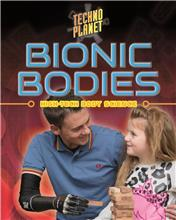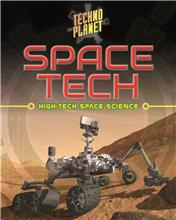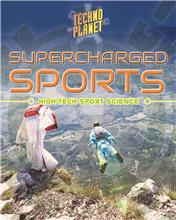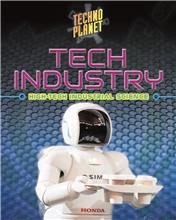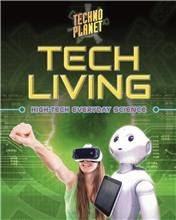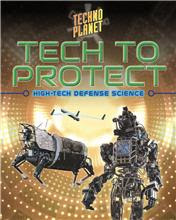| ________________
CM . . . . Volume XXIV Number 22. . . . February 9, 2018
excerpt:
Six titles comprise the new “Techno Planet” series which covers current innovations and advances in technology in a number of disciplines and provides examples of inventions, people and places around the world which employ this technology. Inventions presently in the developmental stages are also discussed. Each title has 13 chapters, including a timeline, while “Techno Planet” text circles contain additional information. There is a slight inconsistency among the titles in that some are fairly general while others are quite technical, the latter requiring, perhaps, a higher comprehension level in the younger readers of the target audience. In any discussion of technology, there are pros and cons. Occasionally, the authors pose questions which compel the reader to think critically and to form an opinion about the long-term benefits of a particular invention (or if, in fact, there is even a real need for it) or to ponder whether the benefits are worth the inherent risks. Here, again, is an inconsistency: some of the titles present a more balanced view than others. Tech to Protect is the most balanced title of the series, perhaps because it deals with more serious topics. One of the concepts which comes up again and again throughout the series is 3-D printing which can be used to create a variety of things, ranging from tools to a living tube that is similar to blood vessels, but nowhere do any of the authors explain how, exactly, a 3-D printer works. Illustrations consist of colour photographs, diagrams and concept drawings. Finally, one wonders how valuable this series will be for a classroom – though it might spark some interesting discussion about technology going too far – and whether the information will date quickly. A glossary, an index, and a list of books and websites for further study are provided. The science of bionics uses technology to create working parts for living things, both inside and outside the body. Bionic Bodies offers many examples of this, from lifelike artificial limbs controlled by sensors and electrical impulses, cochlear implants, and artificial windpipes to tiny devices implanted at the base of the skull to interrupt pain messages in migraine sufferers and exoskeletons worn on the outside of the body that can gradually lessen the amount of support provided to patients as their strength improves. Other topics include nanobots, some of which can deliver drugs to a tumour inside the body, inventions such as the iKnife and the da Vinci machine (a surgical tool and a human-operated surgical robot, respectively), carebots (robots that can clean medical facilities, lift patients and heavy equipment, take blood, and act as receptionists and guides in hospitals), and the ability of smart phones to monitor one's blood sugar and body temperature. The future of cryogenics and grafting body parts is also discussed and might elicit cringes from the reader. Space Tech contains more general information that is quite similar to the info within the “Our Future in Space” series, specifically the topics of space tourism, colonization, and asteroid mining, and the concept of torpor for conserving astronauts' energy. The challenges of space technology encompass the design of spacecraft for manned and unmanned missions, re-entry to Earth's atmosphere and space debris. This title provides a brief history of space stations, such as Skylab, Mir and the ISS, followed by information about space suit design, life on a spacecraft, space probes (e.g. flyby missions, orbiters, landers and rovers) which collect scientific data, and the use of satellites and telescopes such as the Hubble telescope. Readers might find interesting the fact that there is sometimes a trickle-down effect of space science inventions to household and occupational use, some examples of which are that flexible, heat-resistant materials developed by NASA for astronauts' suits are now used in fire-fighting gear while technology used on the Apollo and Gemini missions led to the invention of the cordless mini-vacuum, and freeze-dried food is now carried by hikers and campers. In the sports world, technology is often employed to enhance performance, improve athletes' safety, calculate statistics, watch broadcasts, ensure fair play, and even to make sports more inclusive. Supercharged Sports highlights examples of these, some of which are lighter weight materials for racquets and kayak paddles to reduce fatigue, high-tech wheelchairs for athletes with mobility issues, aerodynamic bike helmets, golf clubs with a larger sweet spot to drive the ball further, light-up mouth guards to indicate the possibility of a football player's concussion, cameras for video analysis of a sporting event, and radio frequency identification tags (RFIDs) which can be worn by NFL players to track their position and speed and transmit the results to the broadcast booth to be shared with fans. Emergency Position Indicating Radio Beacons (EPIRBs) can be used by sailors, skiers and hikers to send rescue signals to satellites which “read” thermal images. Athletes' health can be monitored by wearable fitness devices to ensure optimum performance, with the devices' capability to measure blood pressure, body temperature, pulse, breathing rate and breath volume, calories burned and nutritional requirements. Additional topics include sports injuries, virtual sports, and sports in the future. Gene analysis in the future, for instance, will be able to identify specific sports to which one is predisposed genetically. Though this title showcases several sports which are familiar to the target audience, it might have been a good idea to include more information about the design and development of athletic clothing, shoes and accessories that kids use regularly so that the information is more relatable. Tech Industry focuses on how technology affects farming, retail and commerce, transportation, construction, manufacturing, mining, communication and energy. In this title, readers will learn such terms as “cobotics” (robots working alongside humans), the “Internet of Things” or IoT (a term that is described differently in each of two titles but basically refers to the billions of smart devices that transmit and receive information via the internet), and “augmented reality” or AR (where computer graphics allow the viewer to observe an object from every angle, even from the inside). Other topics include methods of product distribution to reduce the carbon footprint, digital marketing, RFID chips to track livestock, driverless cars and farm machinery, solar-powered transport planes, Li-Fi (similar to Wi-Fi but it uses overhead LED lights to send data to one's computer), and energy-saving building materials, such as LED lighting and shade-changing windows. A few of the challenging questions posed to readers refer to the possible dangers of genetically modified foods and whether or not the tracking and analysis of online behaviour is an invasion of privacy. One minor criticism of this title is that some of the selections of inventions for the timeline at the back of the book are rather questionable, but with so many to choose from, it is probably a difficult task for an author to decide which to include. It seems that almost everything in one's home is becoming more technology-related, from home security systems to the simple task of creating a grocery list. Tech Living begins with a description of the Internet of Things, followed by information presented on topics such as sleep, pet care, clothing, rooms of the house, entertainment and personal transportation. Homes can now be controlled remotely, inluding turning on lights, raising the temperature on the thermostat, and monitoring the activity of pets. Examples of technology in the home include control centres such as Amazon Echo and devices such as robo-vacuums which clean the floors and fridges with interior cameras that record which supplies are running low and add them to the grocery list. People with sleep issues can rely on a smart bed which raises the sleeper's head if s/he is snoring, while those who have difficulty getting up in the morning can now be awakened by an alarm clock that uses scents such as coffee, toast and chocolate rather than a jarring ringtone. Commuters can use WalkCars, which fit into a backpack, or e-bikes to get to work, while packages will soon be delivered to customers in less than 30 minutes by Amazon Prime Air using unmanned aerial vehicles (drones). Google Arts and Culture now weds art with technology by showing famous works of art on the TV screen and bringing museum galleries, such as Ontario's ROM, into one's home; Room2Room, being developed by Microsoft, will allow two people to interact as if they are in the same room while Pilot translates foreign languages in real time. The question that this title begs is, "Of what benefit are some of the latest technologies?" Do people really need the HAPIfork device to tell them if they are eating too fast or a Smart Bowl that measures the exact amount of pet food for one's dog? And truly, of what use is the 2012 Twitter dress that had more than 10,000 LED lights woven into the fabric and could receive real-time tweets? Finally, Tech to Protect examines the ways in which technology is used in warfare as well as how it makes communities safer. The language is carefully chosen in the sections about weapons and warfare, employing words such as “the target” rather than stating that a sniper is shooting at people. Will readers be sophisticated enough to understand or question some of the information presented here? One sentence, referring to a cell phone device which provides information on the location of one's fellow soldiers and enemy targets, states, “Soldiers can then make decisions with less risk of deadly mistakes.” Yes, less risky for their side, but what about the other side? This title also covers stealth vehicles for police and military use; robots for surveillance, bomb detection and disposal, and for finding people buried under debris after a natural disaster or accident; and drones that can take aerial photos, deliver supplies and conduct rescue missions. But drones can also deliver bombs and have accidentally killed innocent civilians, and there is the issue of the misuse of drones by criminals and terrorists. Other topics include the development of specific weapons, such as rifles that can shoot around corners and guns that can recognize the owner's DNA and will not work if they get into another person's hands, infrared goggles, Exoskeletons, lighter and more protective body armour for soldiers, and non-lethal weapons for crowd control. A possible discussion starter is whether or not camera surveillance on city streets is an invasion of privacy, or how a company, industry or city can protect itself from hackers or a computer virus capable of bringing it down. Just how far can technology go and at what cost? There is much food for thought in this title. Generally speaking, "Techno Planet" is a good series, but unless the reader is very astute, the books will be read at a single level of comprehension, that is the knowledge of what exists and what is being developed in the world of technology. The thinkers in the audience, however, can take this knowledge to the next level and weigh the pros and cons of the many and varied inventions presented here. Recommended. Gail Hamilton is a former teacher-librarian in Winnipeg, MB.
Next Review |
Table of Contents for This Issue
- February 9, 2018. |
